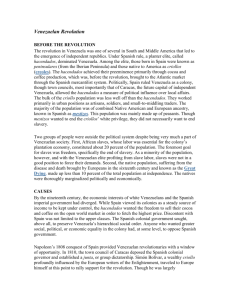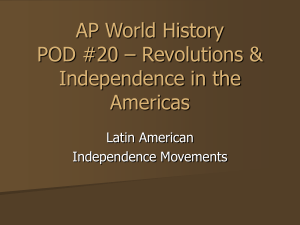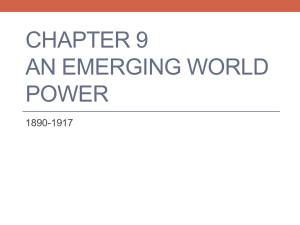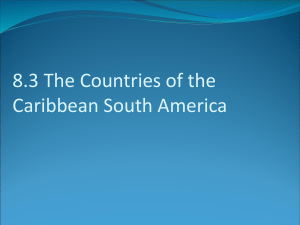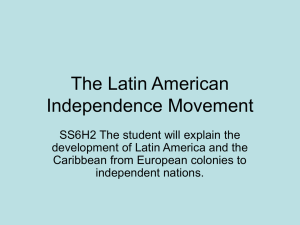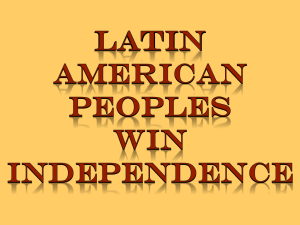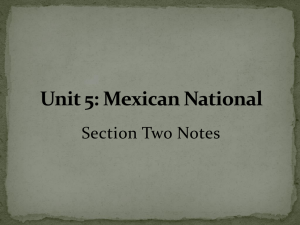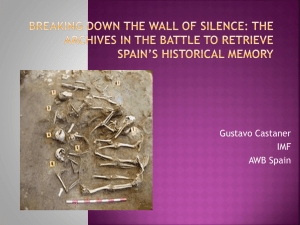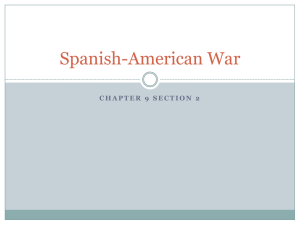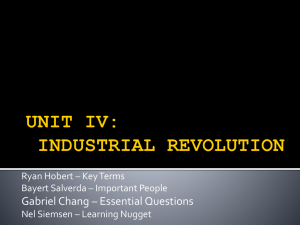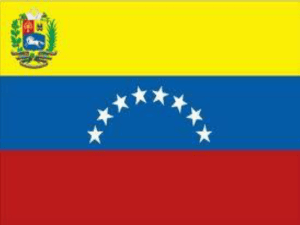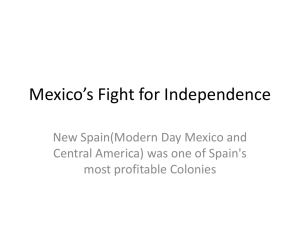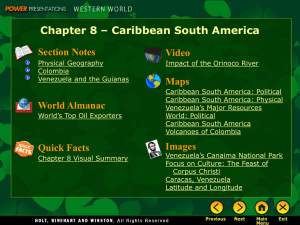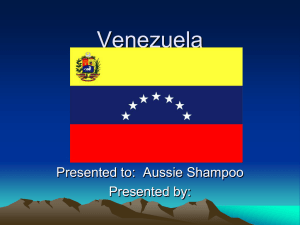Latin American Revolutions PPT
advertisement
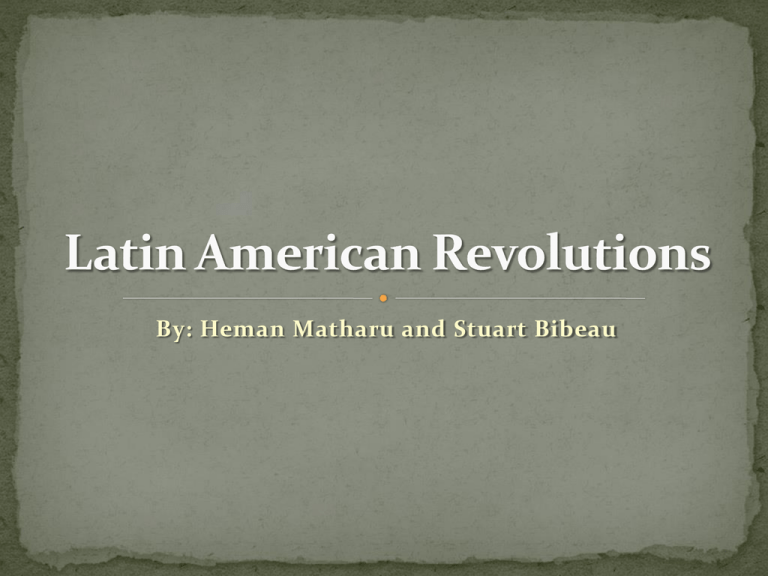
By: Heman Matharu and Stuart Bibeau • 1810-1820 • • • Creoles wanted to extend their power, mainly to assert their power over the Peninsulares. Escape the heavy hand of the Spanish government in implementing high taxes and new government reforms Attempt to unite all types of people - except the Peninsulares - in Mexico to create a non-monarch government • 1811-1823 • • • To abolish the restrictive mercantilism laws by the monarch To revolt against the French acquisition of the crown by Joseph Bonaparte To unite the factions created by the power vacuum caused by the dissolution of the Spanish monarch Struggles and disagreements between along the lines of race, class, and ideology of people in Spanish colonies of Mexico and Venezuela, as a result of Spanish rule Creole landowners and most whites feared social rebellion from lower classes and races such as Native Americans and slaves that made up a majority of population, which had taken land from Native Americans years prior European invasions and attacks by the Portuguese on the Spanish weakened Spanish political authority, money, and will to fight a costly war in Americas Father Hidalgo- rang church bells to speak to community about grievances against Spanish rule, killed by Spanish authorities Agustin de Iturbide- general that conquered Mexico City and several other victories that convinced Spain to grant Mexico independence, first president Simon Bolivar- government and military figurehead that sought to lead Venezuelan independence and combine six South American countries into the Gran Columbia José María Morelos- leader and general of Mexican Revolution after death of Father Hidalgo and took Acapulco and Guerreó Napoleón Bonaparte- general and leader of France, whose invasions of Spain and Portugal put country in disarray, allowing Latin American countries to win independence Francesco de Miranda- Venezuelan general that traveled and brought Enlightenment ideas to Latin America, led creation of First Venezuelan Republic, but tried to flee and was turned into Spanish Painting by Arturo Michelena. Painting by Jose Gil de Castro www.biography.com www.nndb.com www.myartprints.co.uk elrincondelsabanero.blogspot.com September 16 1810, January 2, 1811 Father Hidalgo gives a speech to the crowd about why Mexico should seek independence from Spain, and why they need racial equality and other reforms Spain would not give them Miguel Hidalgo is executed, inspires fellow priests Morelos y Pavón to continue revolution, who was later killed 1810 1825 August 24, 1821, Agustin de Iturbide’s previous military victories leads to the signing of the Treaty of Cordoba , proclaiming Mexican Independence • King Iturbide was ousted as King of Mexico, and a Republic was created one year after he took the throne. • Popular sovereignty was victorious over the monarch, but it did not extend to the peasants or the other lower class citizens. • While women did help Mexico win its independence, women still were disenfranchised. • 500,000 to 1,000,000 people were killed as a result • There were still many conflicts and wars even after the revolution was won. • • • • Both fought against high taxes Both did not grant women equal rights Both did create a Republic Both feared common citizens from ruling, only property owning men could vote. • Mexico did not weaken the power of the church, leaving the Catholic church a prominent power in government • The US had already created a shadow government before the start or the end of the war, while Mexico had to oust its new King of Mexico • Rather than diminishing its tax on mixed race people and Native Americans, Mexico continues to tax them for revenue, as the US removed the government’s ability to tax in the beginning. • King Iturbide was ousted as King of Mexico, and a Republic was created one year after he took the throne. • Popular sovereignty was victorious over the monarch, but it did not extend to the peasants or the other lower class citizens. • While women did help Mexico win its independence, women still were disenfranchised. • 500,000 to 1,000,000 people were killed as a result • There were still many conflicts and wars even after the revolution was won. • • • To abolish the restrictive mercantilism laws by the monarch To revolt against the French acquisition of the crown by Joseph Bonaparte To unite the factions created by the power vacuum caused by the dissolution of the Spanish monarch July 5, 1811 August 7, 1819 Venezuela follows Simon Bolivar’s speech in seeking to lead American independence and declares independence General Simon Bolivar defeats royalist forces in the Battle of Boyacá 1825 June 24, 1821 Spain recognizes Venezuela's independence after Simon Bolivar defeats Spanish troops at Carabobo • • • 800,000 Venezuelans were killed The formation of the Gran Columbia gave suit to the Republic of Venezuela after two Republics of Venezuela were created The resulting government still lent itself to dictatorships by elected presidents, which lead to more conflict • • • Formed a union of many nations (Gran Columbia) and then received pressure to split. Fought against Spain with the mentality that all of them were Venezuelans and not Spanish, similar to what the American colonists practiced. Did not grant equal rights to women, like the American revolution. • • • Broke up from the Gran Columbia to the several nations, including the independent Venezuela. Deep political instability in Venezuela after the war, unlike the Us. The Venezuelan Republic had fallen multiple times before declaring its final independence, while America did not. People of color were oppressed by the White class superior elite rulers The revolutionary movement began when a leader called upon the social minorities to unite against the foreign rule, be it Spanish or French rule First leaders, Toussaint Louverture and Father Hidalgo were killed by the leaders of the country that had control of the colony Helped by the fact that Spain was having trouble fighting against Portugal, Haitians helped by French seeking foreign territory, fight British Haitians fought against French rule, South American revolutions were fought against Spanish rule Bolivar and the Spanish American revolutions did not just free Venezuela, but five other countries, did not unite together like the groups in the Haitian revolution Haitian revolution was primarily a slave revolt, Spanish American revolts were from the lower classes of society, such as African Americans and Native Americans Hidalgo and Mexican revolution also meant to achieve land lost by forefathers to Spanish, Haitians were slaves that wanted freedom The lower classes were of peasants were suppressed by taxes Both inspired by the ideals of the American Revolution and Enlightenment Third Estate resented the upper Estates of social class in France, while African Americans, Mulattos, and Native Americans had little social status in Latin America Leaders of rebellion were killed during the revolution French Revolution was internal disagreement over leadership of the country, decide course of country’s policy, while Spanish American Revolutions were against foreign rule Initial leaders of the French Revolution were killed or replaced by further generations of French Revolutionaries, while Spanish American Revolution only sought to remove the Spanish from power France was strengthened by revolution, Spain was weakened by revolution Works Cited "Agustin De Iturbide (emperor of Mexico)." Encyclopedia Britannica Online. Encyclopedia Britannica, n.d. Web. 14 Feb. 2014. <http://www.britannica.com/EBchecked/topic/298070/Agustin-de-Iturbide>. "Atlantic Revolutions, Global Echoes 1750-1914." Chapter 16 (n.d.): n. pag. Web. “Independence from Spain in Venezuela.” About.com Latin American History. Web. 14 Feb. 2014. "Iturbide - Google Search." Iturbide - Google Search. N.p., n.d. Web. 14 Feb. 2014. <https://www.google.com/search?q=iturbide&ie=utf-8&oe=utf-8&aq=t&rls=org.mozilla:enUS:official&client=firefoxa&source=hp&channel=np#channel=np&q=carabobo+venezuela&rls=org.mozilla:en-US:official>. "Latin American Revolutions: 1800-1914." Timetoast. N.p., n.d. Web. 14 Feb. 2014. <http://www.timetoast.com/timelines/latin-american-revolutions-1800-1914>. “Mexican Revolution.” PBS History Detectives. Web. 14 Feb. 2014. "Mr. Trainor's Page: Stuyvesant High School." Home. N.p., n.d. Web. 15 Feb. 2014. <http://mrtrainor.sharepoint.com/>. “The Mexican Revolution.” National Endorsement for The Humanities. Web. 15 Feb. 2014. “Venezuelan Revolution.” Michigan State University. Web. 14 Feb. 2014. "Venezuela Timeline." Venezuela Timeline. N.p., n.d. Web. 14 Feb. 2014. <http://www.datesandevents.org/places-timelines/42-venezuela-timeline.htm>.
